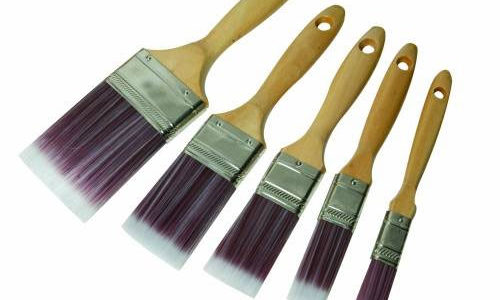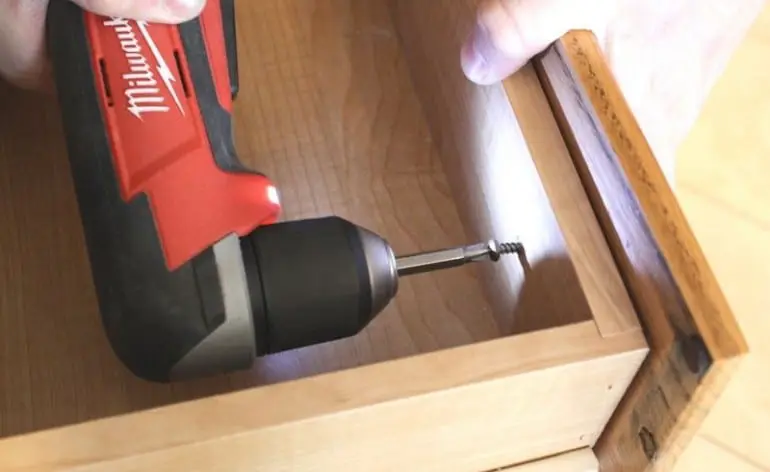Just as any artist has to decide what medium to use, carpenters must decide what wood to work with. The appearance, color, price, intended use, workability, and aging behavior are all considerations. But so is a wood’s paintability or ability to take a stain. If staining, you want to know how the wood grain will show and how the wood color affects the color of the stain. Here’s a quick guide from the Pros who’ve answered the question, “What’s the best wood for painted cabinets?” Also be sure to check out our 15 quick clean-up painting tips.
Blame It On The Grain
Paint-grade wood tends to be of the tighter-grained varieties such as soft maple, hard maple, poplar, and pine, among others. Open-grained wood has a rougher look and likely needs filler to look good when painted. It’s best to build out of tight-grain woods to avoid this. Poplar and soft maple are popular for most parts of a cabinet—face frames, end frames, and door panels—mostly due to cost and workability. However, some carpenters find that poplar dents easily. It can also absorb the first coat of paint quickly. Some of the other tight-grain woods are a little easier to work with, but their availability or cost isn’t considered enough of a trade-off. Hard maple can be another good choice, although it can move slightly more than other woods with changes in humidity.

MDF can be used for face and end frames. Some carpenters use it for door panels, but it can be tricky to finish. Because of this, other wood varieties are often used for rails and stiles. MDF remains popular as it is dimensionally stable and therefore good for larger pieces. Prefinished plywood or birch plywood is another candidate for these longer sections.
So what’s the best wood for painted cabinets?
As with most things, you won’t find any shortage of opinions, but there does seem to be some broad agreement on when the best types of wood are for painted cabinets. Tight-grained woods that are workable and durable remain a popular choice. Whatever material you choose, the overwhelming agreement is to prepare the wood’s surface first. Use filler if needed, shellac on knots so they don’t bleed through, and sand over sharp corners that won’t hold the paint. Here’s a quick breakdown of the woods typically found in cabinets:
- Hickory
Characteristics: strength, hardness, and durability; Reddish brown to white
Grain: typically straight and coarse - Soft Maple
Characteristics: medium density, hardness, and strength, paint grade
Grain: close-grained, fine textured - Red Oak
Characteristics: very hard, heavy, and strong
Grain: coarse texture with excellent sanding and finishing properties - Knotty Pine
Characteristics: lightweight with small and tight knots
Grain: straight with a fine, even texture - Alder
Characteristics: reddish brown color, similar to Cherry; easily dented
Grain: straight grain and even texture - Cherry
Characteristics: moderately heavy, hard, and strong; sands extremely smooth
Grain: red and finishes beautifully - Hard Maple
Characteristics: dense, light, and consistent in color
Grain: stain grade , fine textured and close grained (doesn’t require filling) - Mahogany
Characteristics: varies slightly in color from a light reddish brown to a medium red
Grain: straight to interlocked grain; medium coarse texture - Red Birch
Characteristics: red in color; softer than Red Oak
Grain: tight grain; very easy to finish - Beech
Characteristics: heavy, pale -colored, medium-to-hard wood; stains and polishes well
Grain: fine, tight grain; similar in appearance to maple and birch - White Oak
Characteristics: from very light to dark brown color; hard and heavy wood
Grain: straight grained wood with medium to coarse texture - Douglas Fir
Characteristics: light rosy colored wood that reddens
Grain: tight knotted and close-grained
We hope you now have some better tools to answer the question, “What’s the best wood for painted cabinets?” If you’re a Pro, and you have a cabinet painting tips, add them in the comments below—or contact us with your own Pro tips.



